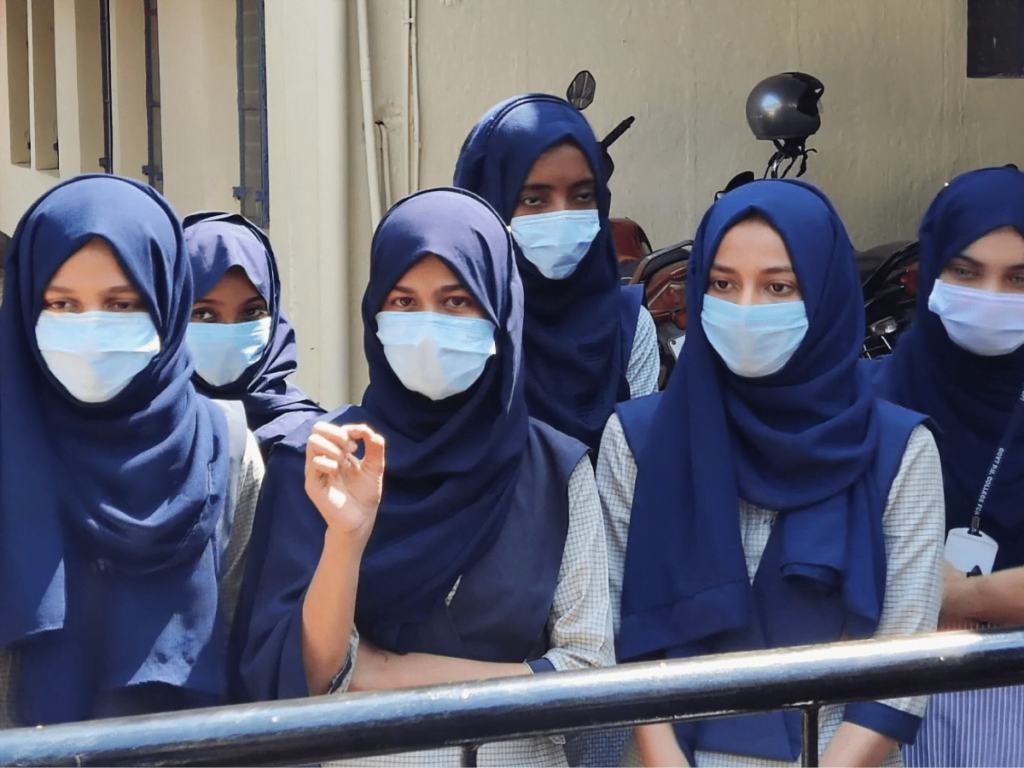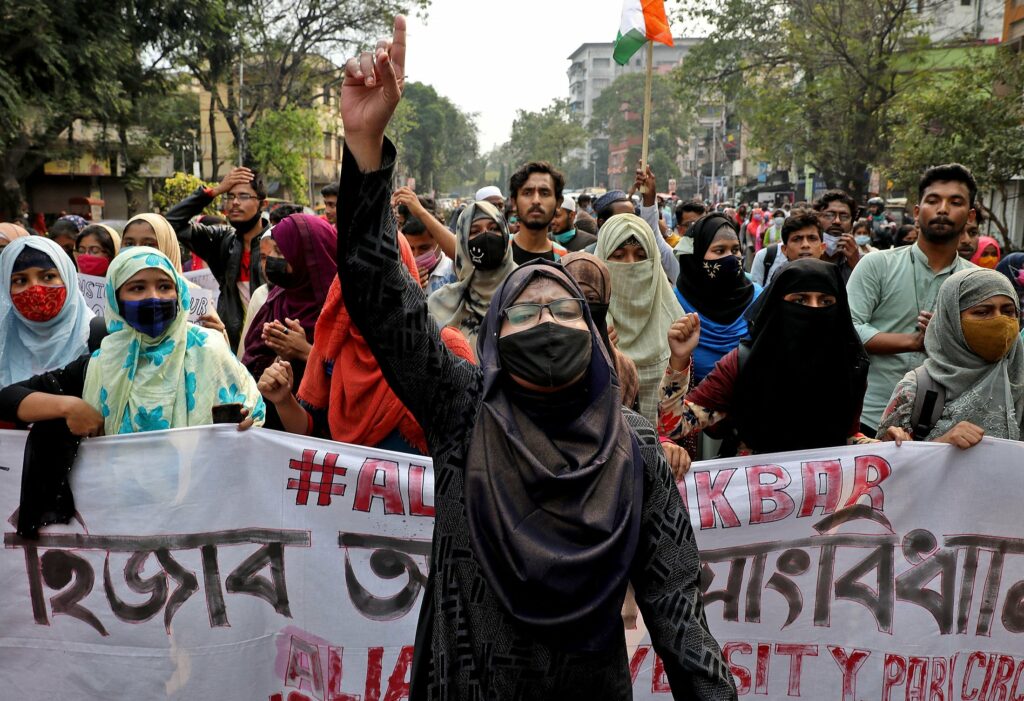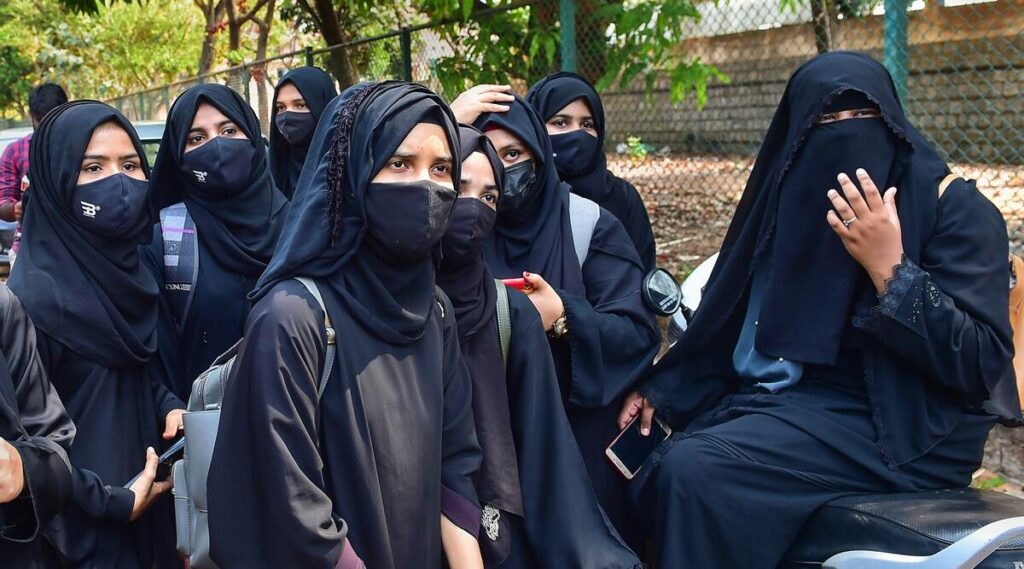Attending an International Indian school never meant being distant from national identity. Growing up under the ethos of a ‘secular’ environment, alongside Hindu and Christian classmates, students with a rosary, bindi, or Hijab at school were a common sight. The freedom to don one’s religious identity never deterred them from chanting ‘Jai Hind’ with full fervor. Every single student was an Indian, regardless of their hijabs, skull caps, bindis, and turbans.
The Karnataka Hijab row
In 2022, the Karnataka Hijab row engendered a discourse on secularism and religious freedom. Justices Sudhanshu Dhulia and Hemant Gupta’s dissimilar views on ‘Secularism’ depict the repulsion between Indian politics and its secular past. In the end, it is the young Muslim women who have to bear the brunt of the constant delays in SC hearings and the overall political climate.

A while ago, all the national dailies were busy celebrating the 50th anniversary of the Kesavananda Bharati case that upheld the basic structure doctrine. In another scenario, young female students are deprived of their fundamental right to education, religion, and privacy. Adding to their academic woes is the fact that at a stage where students often worry about what career path to choose – these young women are doused in an identity crisis.
Courts interpreting religions’ doctrine
As per the three-bench Karnataka HC ruling, Hijab is not an essential practice of Islam. However, the intricacies of this interpretation were clearly beyond the scope of legal authority. Even though clause (2) of Article 19 pertains to reasonable restrictions that can be imposed on the ground of public order, this act simply does not sit well with matters of personal religious inclinations.

While Iranian women fight for their right to take off the hijab under an authoritarian theocratic regime, the women in the largest democracy of the world are deprived of their right to religious expression. This raises concerns about the agency of women that often does not lie with them. A headscarf could be her personal sentiment; why does it have to become a symbol of targeted politics?
The balancing act
An article by Irena Akbar entailed the story of Tabassum Shaikh, a prodigal student from Karnataka who decided to choose her education over her religion. Hers is the story of a girl who emerged as a topper despite all odds. In reality, it is an account of the choices controlled by the State. Shaikh’s tale also includes a supportive family whereas, in the words of Justice Dhulia, the hijab was a ticket to education for many other Muslim girls from conservative families in the state. The young girls are walking on a tightrope, some of them tread towards education whereas others have to head back home.
Also Read: From Hijab Ban To Bulli Bai/Sulli Deals: The Muslim Women’s Assertion Against The Hindutva
How long can this balancing act possibly continue? Article 25 under part three of the Constitution envisages the free ‘profession, practice and propagation’ of religion. Is this not at a crossroads with the fundamental right to education? It puts the young Muslim generation under an identity crisis, as they try to navigate the deep waters between their religious and national identity.
Schools: Public spaces or jails?
Since childhood, it is taught that the teachers are second ‘parents’. In today’s time, a child spends more hours at school than in their houses. These so-called second homes are gradually morphing into unwelcoming spaces. The iron bars of a school gate have transformed into that of a prison for certain religious communities. Hindu morning prayers have always been the norm, no court would ever bring up ‘reasonable restrictions’ in that case. Yet, a Hijab has the potential to invoke 19 (2).

The state-funded schools are meant for all citizens of the country, without discrimination on any bases. Justice Dhulia raised a fine assertion that schools are public places and curbing the wearing of the Hijab is a restriction of the fundamental right to privacy as well as religion. Students are singled out and pushed from the academic spaces. Some of them even leave voluntarily, thus losing all autonomy to gain an education.
Education has always remained a means to political ends. Even the Spartans and the Athenians had their own agendas with regard to it – the former upheld military training whereas the latter was centred around diplomacy, politics, and art. Kingdoms have crumbled, yet the means remain. In the name of ‘syllabus-rationalisation’ the Indian government continues to selectively lessen the burden on students by removing chapters on democracy, secularism, and important parts of history.
Can the Karnataka Hijab ban be termed as the rationalisation of the nation then? Because apparently, the one-roof-one-culture seems to be the pith and substance behind such laws. A Muslim woman wakes up to a State that wants to put her identity in a slumber. Her survival in such a situation, both politically and socially has become very complex. No wonder that today, secularism is mocked by the youth themselves. Its meaning has blurred amid these divisive lines.
Nationalism: A question mark for the minorities
Tagore’s nationalism urged the men and women to break free of the shackles within their minds. When nationalism starts to tilt towards the majoritarian religion, it leaves no scope for the essence of the nation i.e. the diversity that defines India. The onus of carrying the burden of these shackles falls on the shoulders of these girls. ‘Education is light’ is an adage that bears no meaning now. The path toward education has become a bleak remnant drowning in political chaos.

Singing the national anthem is not an act of patriotism anymore but is a glance that paints a question mark on the priorities of a Muslim. It says, ‘Who are you, a Muslim or an Indian?’ and it is this very silent distinction that unearths their identity crisis. According to Ashutosh Varshney, a political scientist, the basic rationale for making the concept of ethnicity broader is to examine the intensity of attachment. Earlier, it used to encompass kinship and language but in modern times, it includes caste and religion as well. He says that such ‘identity markers’ have been generated that are used for mobilisation and unleashing enormous passion. It has also taken the form of violence. Hence, the pendulum of identity rotates between the examination of intensity and the outburst of that passion.
Varshney further highlights how defining a nation, without the context of politics, is impossible in India. A nation means building a political roof over your cultural head. Under the dark clouds of today’s political climate, Indian nationalism places minority groups in a hurricane of mental frustration.
Religious symbols and politics
As per a study on symbolism and politics, there can never be a single interpretation of religious symbols. This multivocality of symbols means that symbolic discourse is a battleground of ideas and interpretations as individuals and groups struggle over political questions seeking to mobilise symbols in support of their cause, according to the authors.
The hijab is seen as a symbol of obstruction to the norm because it somehow translates to a threat, as stated by the government. It makes me wonder how a mere piece of cloth, to an outsider, can pose a threat so great that it invokes 19 (2) – reasonable restrictions regardless of the religious interpretation it carries for a Muslim woman. Justice Sudhanshu Dhulia has rightly brought up ‘reasonable accommodation’ as opposed to the former doctrine.
If mass applications can be submitted to a college against a symbol that clearly falls under the spectrum of ‘personal beliefs’, then how is politics not infiltrating the public education sector in India? This raises concerns in terms of the quality of education and the kind of values that are left behind for the generations to come. Roots of communal disharmony rot the nation from within.
The aftermath
In an aftermath that spells helplessness for the Indian Muslim women, whose identity is dissected into Indian, Muslim, and woman; an examination becomes imperative. How does this create a long-term impact on them? Women in every community and religion have been ‘the other’ gender for eons, as elucidated by Simone De Bouvier in her feminist Bible, ‘The Second Sex‘. This level of treatment puts them in a very disadvantageous position. Even though Tabassum Shaikh’s account can be held under a banner of progression in Muslim society, why does a girl as young as her have to make such a choice? Why does she have to undergo emotional turmoil by removing her visible religious identity in the ‘Mother of all democracies’ as stated by the PM?
With the growing Indian population, policies centered around mobilising the youth and making education a symbol of equality – instead of dividing them on the basis of religion – can bolster the nation’s growth in imminent ways. But as elucidated earlier, politics is a pandora’s box that comes with religion, caste, and gender as its major constituents. If these grounds aren’t secluded and pricked upon, politics wouldn’t survive.
In the past few years, the term ‘Indian Muslim’ has become synonymous with an identity crisis. Be it the classroom lectures on terrorism, a communal riot in some part of the country involving a Muslim, morning assemblies at schools where national anthems are read – no space is free from the clutches of politics, glances that question allegiance and carry multiple allegations in its folds.
Also Read: Karnataka Hijab Row: Clothing, Secularism And A Nation In Danger




